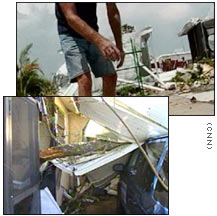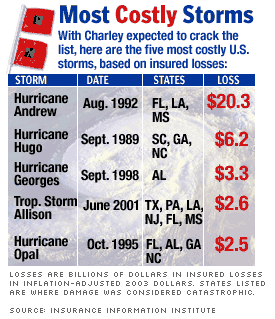NEW YORK (CNN/Money) -
Insurers were trying Monday to sharpen loss estimates for Hurricane Charley, which could emerge as the second-costliest storm in the nation's history.
 |
|
| Damage from Hurricane Charley appears likely to make it the most expensive natural disaster of the last 10 years. |
The Category 4 hurricane, the second-strongest rating for a storm's strength, crossed Florida from the Gulf of Mexico late Friday and struck the Carolinas with diminished force Saturday. The storm killed at least 17 people, Florida officials said Monday.
While Florida Gov. Jeb Bush put loss estimates at $15 billion over the weekend, the insured losses could be considerably less. One insured loss estimate was as low as $5 billion, and another put insured losses at $7 billion to $14 billion.
The state-run Citizens Property Insurance Corp., the insurer of last resort that has 815,000 policyholders around the state, estimated its losses from Charley would come to $1.2 billion. But the insurer, which has the power to levy assessments on other insurers in case of a deficit, said it believes it has the resources on hand to pay those claims.
Allstate Insurance, the nation's largest investor-owned personal insurer and the No. 3 writer of homeowners' insurance in Florida, warned Monday that losses cannot yet be estimated, but that they could affect the company's third-quarter earnings. But Allstate added the hurricane would not have a material impact on its overall financial condition.
Shares of Allstate (ALL: up $0.62 to $46.55, Research, Estimates) rose about 1 percent in afternoon trading.
Smaller insurers face a bigger risk, especially those with a big chunk of business in Florida.

One smaller Florida-based insurer warned Monday it would be seeking higher premiums to cover its losses from the storm. Plantation, Fla.-based Federated National Insurance Co. said the higher rates were necessary to cover increased reinsurance costs ahead.
Federated National, owned by 21st Century Holding Co., also warned it would take a charge of $1.25 a share in the current quarter, lowering its earnings guidance for the year and sending 21 Century (TCHC: Research, Estimates) stock down about 5 percent Monday, after tumbling 9 percent Friday.
Insurers' losses could be limited by the existence of the Florida Hurricane Catastrophe Fund, a state entity that reimburses insurers for losses on residential policies when more expensive storms hit the state, up to a industrywide cap of about $15 billion. But the fund only triggers if losses reach a certain level.
Allstate said the fund should reimburse it for up to $636 million in losses, after the insurer makes initial payments of $286 million.
Insurers also have private reinsurance that limit their risk.
| Other storm coverage
|

|
|
|
|
Munich Re, the world's largest reinsurer, estimated Monday that insured losses from the storm would be in the $7 billion to $14 billion range. It said its loss is likely to be about $250 million.
Shares of Munich Re closed trading up about 1 percent in Frankfurt Monday.
Even the lower end of Munich Re's estimates would put Charley second only to 1992's Hurricane Andrew, which had inflation-adjusted insured losses of $20.3 billion, in terms of the nation's most expensive storms. Currently, the second-most expensive storm on the Insurance Information Institute's list is 1989's Hurricane Hugo, at $6.2 billion.
Charley is virtually certain to be the most expensive natural disaster in the decade since the Northridge, Calif., earthquake, which had inflation-adjusted insured losses of about $15 billion.
| 
| |

| 
| 
|

|
 One of the first things you need after a disaster is get your insurance company on the case. Jeanne Salvatore, vice president of consumer affairs at the Insurance Information Institute, offers tips. One of the first things you need after a disaster is get your insurance company on the case. Jeanne Salvatore, vice president of consumer affairs at the Insurance Information Institute, offers tips.
|
 Play video
Play video
(Real or Windows Media)
|
| 
|

|
|
Risk Management Solutions, a firm that does catastrophe modeling and estimates for the insurance industry, said Saturday that insured losses could be as low as $5 billion, down from its previous $10 billion estimate, because the center of the storm where winds were strongest ended up being a relatively contained area.
AIR Worldwide, another catastrophe modeling firm, estimated losses at $6 billion to $10 billion.
The Wall Street Journal reported Monday that also limiting industry losses are some limits on hurricane coverage that became common in Florida after Andrew. One common feature: a hurricane deductible of 2 percent or more of a home's insured value. That would leave homeowners responsible for the first $6,000 in damage on a $300,000 home.
Some insurers are also capping coverage at a certain percentage above a home's insured value, rather than at a less-defined full replacement cost, according to the paper.
While wind damage from a hurricane is covered on most property and casualty policies, flood damage rarely is covered by private insurers and therefore not included in most loss estimates.
Federal flood insurance is the only source of flood coverage, and homes not in flood plains often times are without flood insurance, meaning water damage can be uninsured.
The insurance industry is not the only one to take a hit from the storm.
The Florida Citrus Mutual, the association of Florida citrus growers, said that three of the largest citrus-producing counties -- DeSoto, Hardee and Polk -- saw groves, barns and equipment destroyed by the storm.
At the New York Board of Trade, the September contract for orange solids jumped 7.25 cents, or 11.6 percent, to 69.5 cents a pound. November futures jumped 5 cents, or 8 percent, to 68 cents.
Growers had just harvested this year's crop, but next spring's crop is likely to be affected.

|

